#WebSockets
Explore tagged Tumblr posts
Text
I'm making a second attempt at learning web socket. May the CORS gods be merciful this time.
7 notes
·
View notes
Text
ohhhhh fuck just realized I'm gonna have to write websocket code in fucking kotlin (or I could use java, but I think that's worse) eventually. websockets in rust were gross enough, I don't even wanna think about how awful they're going to be in kotlin
7 notes
·
View notes
Text
Load Balancing Web Sockets with K8s/Istio
When load balancing WebSockets in a Kubernetes (K8s) environment with Istio, there are several considerations to ensure persistent, low-latency connections. WebSockets require special handling because they are long-lived, bidirectional connections, which are different from standard HTTP request-response communication. Here’s a guide to implementing load balancing for WebSockets using Istio.
1. Enable WebSocket Support in Istio
By default, Istio supports WebSocket connections, but certain configurations may need tweaking. You should ensure that:
Destination rules and VirtualServices are configured appropriately to allow WebSocket traffic.
Example VirtualService Configuration.
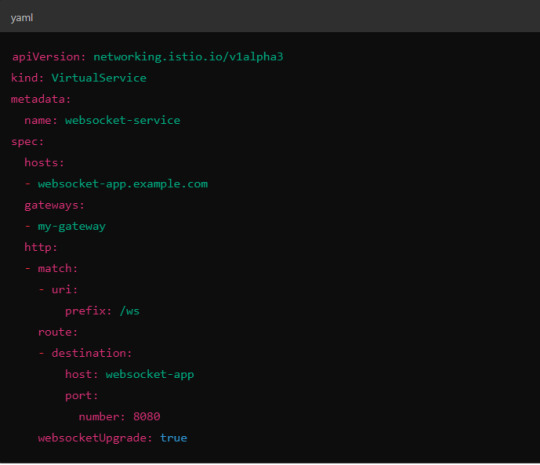
Here, websocketUpgrade: true explicitly allows WebSocket traffic and ensures that Istio won’t downgrade the WebSocket connection to HTTP.
2. Session Affinity (Sticky Sessions)
In WebSocket applications, sticky sessions or session affinity is often necessary to keep long-running WebSocket connections tied to the same backend pod. Without session affinity, WebSocket connections can be terminated if the load balancer routes the traffic to a different pod.
Implementing Session Affinity in Istio.
Session affinity is typically achieved by setting the sessionAffinity field to ClientIP at the Kubernetes service level.
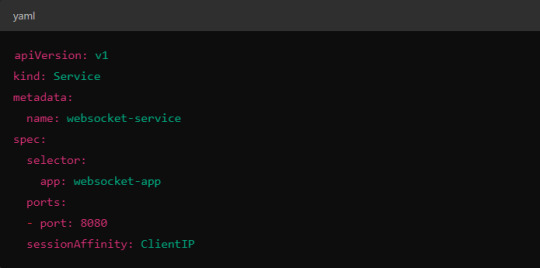
In Istio, you might also control affinity using headers. For example, Istio can route traffic based on headers by configuring a VirtualService to ensure connections stay on the same backend.
3. Load Balancing Strategy
Since WebSocket connections are long-lived, round-robin or random load balancing strategies can lead to unbalanced workloads across pods. To address this, you may consider using least connection or consistent hashing algorithms to ensure that existing connections are efficiently distributed.
Load Balancer Configuration in Istio.
Istio allows you to specify different load balancing strategies in the DestinationRule for your services. For WebSockets, the LEAST_CONN strategy may be more appropriate.
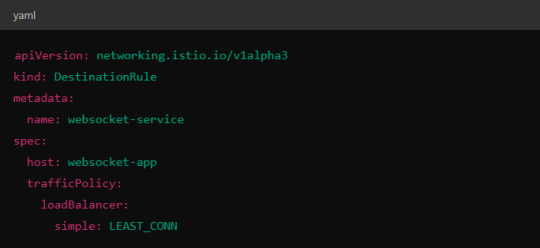
Alternatively, you could use consistent hashing for a more sticky routing based on connection properties like the user session ID.
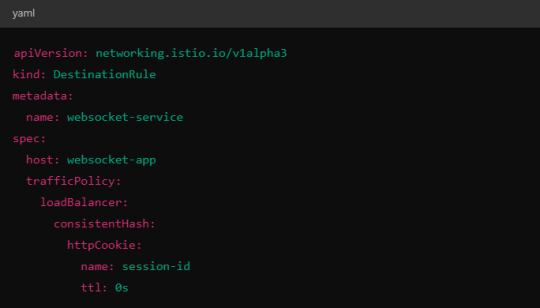
This configuration ensures that connections with the same session ID go to the same pod.
4. Scaling Considerations
WebSocket applications can handle a large number of concurrent connections, so you’ll need to ensure that your Kubernetes cluster can scale appropriately.
Horizontal Pod Autoscaler (HPA): Use an HPA to automatically scale your pods based on metrics like CPU, memory, or custom metrics such as open WebSocket connections.
Istio Autoscaler: You may also scale Istio itself to handle the increased load on the control plane as WebSocket connections increase.
5. Connection Timeouts and Keep-Alive
Ensure that both your WebSocket clients and the Istio proxy (Envoy) are configured for long-lived connections. Some settings that need attention:
Timeouts: In VirtualService, make sure there are no aggressive timeout settings that would prematurely close WebSocket connections.

Keep-Alive Settings: You can also adjust the keep-alive settings at the Envoy level if necessary. Envoy, the proxy used by Istio, supports long-lived WebSocket connections out-of-the-box, but custom keep-alive policies can be configured.
6. Ingress Gateway Configuration
If you're using an Istio Ingress Gateway, ensure that it is configured to handle WebSocket traffic. The gateway should allow for WebSocket connections on the relevant port.
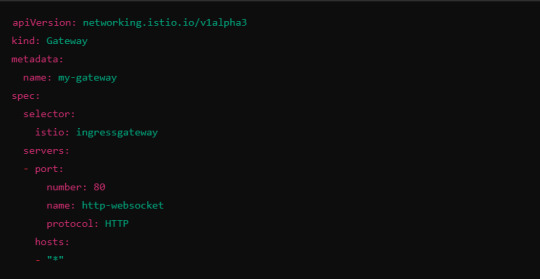
This configuration ensures that the Ingress Gateway can handle WebSocket upgrades and correctly route them to the backend service.
Summary of Key Steps
Enable WebSocket support in Istio’s VirtualService.
Use session affinity to tie WebSocket connections to the same backend pod.
Choose an appropriate load balancing strategy, such as least connection or consistent hashing.
Set timeouts and keep-alive policies to ensure long-lived WebSocket connections.
Configure the Ingress Gateway to handle WebSocket traffic.
By properly configuring Istio, Kubernetes, and your WebSocket service, you can efficiently load balance WebSocket connections in a microservices architecture.
#kubernetes#websockets#Load Balancing#devops#linux#coding#programming#Istio#virtualservices#Load Balancer#Kubernetes cluster#gateway#python#devlog#github#ansible
5 notes
·
View notes
Text
In modern web applications, real-time communication is a highly demanded feature, especially in chat applications. The ability to send and receive messages in real-time enhances the user experience, making apps more interactive and engaging.
In this tutorial, we’ll walk you through building a real-time chat application using React, Node.js, and Socket.io. Socket.io is a popular JavaScript library that enables real-time, bi-directional communication between web clients and servers.
By the end of this tutorial, you'll have a working real-time chat app where multiple users can communicate instantly.
#React#NodeJS#SocketIO#RealTimeChat#WebDevelopment#JavaScript#ChatApp#NodeJSBackend#ReactFrontend#WebSockets#RealtimeCommunication#FullStackDevelopment#ReactApp#SocketIOChat#WebAppDevelopment#JavaScriptFrameworks#RealtimeApp#MessagingApp#FrontendDevelopment#BackendDevelopment#APIIntegration#NodeExpress#RealTimeApp#AppDevelopment#WebAppFeatures#SocketIOConnection#ReactJS#NodeJSApp
0 notes
Text
Hire Expert SignalR Engineers for Real-Time Chat Solutions

In today's digital landscape, real-time communication has become a cornerstone for engaging and interactive web applications. Whether it's live chat, instant notifications, or collaborative tools, users expect instantaneous responses. This demand underscores the importance of integrating real-time functionalities into web applications. For businesses leveraging the ASP.NET framework, SignalR emerges as a powerful library that facilitates real-time web capabilities. However, to harness the full potential of SignalR, it's imperative to hire skilled SignalR engineers who can seamlessly integrate these features into your applications.Flexiple+2CSharp+2CSharp+2Microsoft LearnMicrosoft Learn+3Wikipedia+3CSharp+3
Understanding SignalR and Its Significance
SignalR is an open-source library for ASP.NET developers that simplifies the process of adding real-time web functionality to applications. It enables server-side code to push content to connected clients instantly, eliminating the need for clients to repeatedly poll the server for updates. This capability is particularly beneficial for applications requiring high-frequency updates, such as chat applications, live dashboards, and collaborative platforms.CSharp+1Wikipedia+1Microsoft Learn+2Wikipedia+2Ghanshyam Digital Blog+2
By utilizing SignalR, developers can implement features like two-way communication between the server and client, automatic connection management, and the ability to scale applications efficiently. This makes SignalR an invaluable tool for creating dynamic and responsive user experiences.GitHub+8Ghanshyam Digital Blog+8CSharp+8CSharp+6Invincix+6CSharp+6
Why Hire Expert SignalR Engineers?
Integrating SignalR into your applications requires a deep understanding of both the library itself and the broader ASP.NET ecosystem. Expert SignalR engineers possess the technical prowess to implement real-time features effectively, ensuring that your application remains robust, scalable, and responsive. They can navigate the complexities of real-time communication, handle connection management adeptly, and optimize performance to deliver seamless user experiences.GitHub+10CSharp+10Wikipedia+10Flexiple
Moreover, experienced SignalR developers can anticipate potential challenges and implement best practices to mitigate them, ensuring that your application remains reliable under varying loads and usage scenarios.
Key Skills to Look for When Hiring SignalR Engineers
When seeking to hire SignalR engineers, consider the following essential skills and qualifications:
Proficiency in ASP.NET and C#: A strong foundation in ASP.NET and C# is crucial, as SignalR is built on these technologies.Microsoft Learn+3Flexiple+3Wikipedia+3
Experience with Real-Time Web Technologies: Familiarity with WebSockets, Server-Sent Events, and long polling techniques is essential for implementing real-time features.
Understanding of Client-Side Technologies: Knowledge of JavaScript, HTML5, and front-end frameworks enhances the ability to integrate SignalR with the client side effectively.
Database Integration Skills: Ability to integrate real-time features with databases to ensure data consistency and reliability.Flexiple
Problem-Solving Abilities: Strong analytical skills to troubleshoot and optimize real-time communication features.Arc+7Flexiple+7ClickUp+7
Crafting an Effective Job Description for SignalR Engineers
To attract top-tier SignalR talent, your job description should be clear and comprehensive. Here's a template to guide you:
Job Title: SignalR EngineerMicrosoft Learn+7Indeed+7ClickUp+7
Job Summary:
We are seeking a skilled SignalR Engineer to join our dynamic team. The ideal candidate will have extensive experience in developing real-time web applications using SignalR and ASP.NET. You will be responsible for designing, implementing, and maintaining real-time communication features that enhance user engagement and experience.
Key Responsibilities:
Develop and integrate SignalR-based real-time features into web applications.
Collaborate with front-end developers to ensure seamless integration between server and client sides.
Optimize application performance and scalability.
Troubleshoot and resolve issues related to real-time communication.
Stay updated with the latest industry trends and technologies to ensure our applications remain current and competitive.
Qualifications:
Proven experience as a SignalR Engineer or similar role.Indeed+6ClickUp+6ClickUp+6
Strong knowledge of ASP.NET, C#, and real-time web technologies.Flexiple+2CSharp+2Wikipedia+2
Experience with client-side technologies such as JavaScript and HTML5.
Excellent problem-solving skills and attention to detail.
Strong communication and teamwork abilities.
Interview Questions to Evaluate SignalR Engineers
To assess the competency of potential hires, consider asking the following questions:
Can you explain how SignalR facilitates real-time communication in web applications? This question evaluates the candidate's understanding of SignalR's core functionality and its role in enabling real-time features.
How does SignalR handle connection management, and what strategies can be employed to ensure scalability? This assesses the candidate's knowledge of connection handling and their ability to design scalable solutions.
Describe a challenging project where you implemented SignalR. What obstacles did you face, and how did you overcome them? This provides insight into the candidate's practical experience and problem-solving capabilities.
How do you ensure data consistency and reliability in a SignalR-based chat application? This question probes the candidate's understanding of maintaining data integrity in real-time applications.
What are the security considerations when implementing SignalR in an ASP.NET application? This evaluates the candidate's awareness of potential security risks and their ability to implement appropriate safeguards.
Benefits of Hiring SignalR Engineers for Real-Time Chat Solutions
Investing in skilled SignalR engineers offers several advantages:Flexiple+1WiFi Talents+1
Enhanced User Engagement: Real-time features like instant messaging and live notifications keep users engaged and improve overall satisfaction.
Competitive Advantage: Implementing cutting-edge real-time functionalities can set your application apart in a crowded market.
Scalability: Expert engineers can design solutions that scale efficiently, accommodating growing user bases without compromising performance.
Reliability: Experienced developers ensure that real-time features are robust and reliable, minimizing downtime and enhancing user trust.
FAQs
FAQs (Continued)
Q2: What types of applications benefit most from SignalR integration? A2: Applications that require real-time data updates such as chat apps, live dashboards, collaborative editing tools, online gaming platforms, and stock market trackers greatly benefit from SignalR integration due to its low-latency communication.
Q3: Is SignalR compatible with all browsers and devices? A3: Yes, SignalR provides automatic fallback mechanisms. If WebSockets (its primary transport) aren’t supported, it falls back to Server-Sent Events or long polling, ensuring compatibility across most modern browsers and devices.
Q4: Can SignalR be used with frontend frameworks like React or Angular? A4: Absolutely. SignalR has JavaScript and TypeScript client libraries that make it easy to integrate with popular frontend frameworks including React, Angular, Vue, and others.
Q5: How does SignalR handle scalability in large-scale applications? A5: SignalR can be scaled using backplanes such as Redis or Azure SignalR Service. These tools allow messages to be distributed across multiple servers, ensuring real-time communication even as the application grows.
Q6: What security practices should be followed when using SignalR? A6: Use HTTPS to encrypt data, implement authentication and authorization to control access, validate user inputs, and protect against common threats such as cross-site scripting (XSS) and cross-site request forgery (CSRF).
Conclusion
Incorporating real-time communication into your web applications is no longer a luxury—it's a necessity for staying competitive in today’s fast-paced digital world. SignalR provides a robust framework for implementing these features within ASP.NET environments, offering seamless and scalable real-time capabilities.
By hiring experienced SignalR chat engineers, you ensure that your applications are equipped with the latest in real-time technology, delivering instant feedback, superior user engagement, and a modern interactive experience. Whether you're building a live chat platform, a collaborative workspace, or a real-time notification system, the right talent will make all the difference.
So don’t just build applications—build real-time experiences that users love. Hire expert SignalR engineers and future-proof your digital solutions today.
#hireSignalREngineer#SignalRChat#RealTimeCommunication#SignalRDevelopers#ASPNETCore#SignalRApplication#LiveChatApp#RealTimeChat#ASPNETCoreSignalR#ChatApplication#SignalRHub#SignalRWebSockets#ASPNETChatApp#HireSignalRDeveloper#RealtimeMessaging#DotNet8#WebSockets#ChatWithSignalR#DotNetDeveloper#ASPNetCore8#SignalRChatApplication#SignalRWithNet8#TechHiring#FullStackDeveloper#NetChatApp
0 notes
Text
Mastering Event-Driven Programming in Python
Me learn Python magic! Make fire with asyncio, make big noise with Tkinter, talk fast with WebSockets, and hunt big data with FastAPI. Me test, me debug, me become Python master! Join now, make code dance!
Yo, fam! 🔥 Get ready to SLAY event-driven programming in Python! 🚀- **asyncio** - Code like a boss without blocking! - **GUI** - Whip up some dope apps with Tkinter! - **WebSockets** - Keep it LIT with real-time updates! - **FastAPI** - Build some next-level microservices! - **Debugging** - Fix your code like a PRO! Grab this book, dive in, and LEVEL UP your Python game! 💪
Book -> Free

0 notes
Text
How WebSockets Enable Real-Time Communication for Full Stack Developers
0 notes
Text
0 notes
Text
Building Real-Time Notifications with Django Channels: A Step-by-Step Guide
Introduction:In today’s dynamic web applications, real-time features such as notifications, chat, and live updates have become increasingly important to enhance user engagement and experience. Django Channels extends Django to handle WebSockets, allowing you to build real-time applications. By integrating Django Channels into your project, you can implement real-time notifications that alert…
#asynchronous programming#Django#Django Channels#Python#Real-Time Notifications#web development#WebSockets
0 notes
Text

Call Now For Creating Your Responsive Website!!
0 notes
Text
Understanding Real-Time APIs: Types and Their Optimal Uses
Introduction to Real-Time APIs
Real-time APIs have revolutionized how data is communicated and processed, enabling instant data transfer and updates. These APIs facilitate seamless interactions, ensuring that information is exchanged swiftly and efficiently. This article delves into the various types of real-time APIs and their optimal uses, providing a comprehensive understanding of their applications in different domains.
Types of Real-Time APIs
WebSockets
WebSockets offer a full-duplex communication channel over a single, long-lived connection. This technology is essential for applications requiring constant data flow, such as chat applications, online gaming, and live updates.
Key Features of WebSockets
Bidirectional Communication: Allows for sending and receiving data simultaneously.
Low Latency: Provides near-instantaneous data transmission.
Persistent Connection: Maintains a stable connection, reducing overhead from frequent handshakes.
Read More: BUILDING REAL-TIME APIS WITH WEBSOCKETS AND TOOLS
Server-Sent Events (SSE)
Server-sent events (SSE) are used to push updates from a server to a client over a single HTTP connection. Ideal for applications needing consistent updates, such as live news feeds, stock tickers, and social media streams.
Advantages of SSE
Simple Implementation: Easier to implement compared to WebSockets.
Automatic Reconnection: Handles reconnections and updates efficiently.
Event-Driven: Only sends data when there are updates, conserving resources.
Long Polling
Long Polling is a technique where the client requests information from the server with the server holding the request open until new data is available. This method is suitable for applications where WebSockets are not supported.
Benefits of Long Polling
Compatibility: Works with existing HTTP infrastructure.
Reduced Latency: Provides a semblance of real-time communication without needing a persistent connection.
gRPC
gRPC is a high-performance RPC framework that uses HTTP/2 for transport. It's designed for low latency and high throughput communication, making it ideal for microservices and distributed systems.
Core Features of gRPC
Language Agnostic: Supports multiple programming languages.
Efficient: Utilizes HTTP/2 for multiplexing and compressing messages.
Streaming: Supports bi-directional streaming, enabling continuous data flow.
Optimal Uses of Real-Time APIs
Financial Services
In financial services, real-time APIs are crucial for providing instantaneous updates on stock prices, market data, and transaction statuses. WebSockets and SSE are commonly used to ensure traders and investors receive up-to-the-second information.
Healthcare
In healthcare, real-time APIs facilitate the rapid exchange of patient data, remote monitoring, and telemedicine services. gRPC and WebSockets are often employed to ensure secure and timely data transfer.
E-Commerce
E-commerce platforms utilize real-time APIs to update inventory, track shipments, and manage customer interactions. Long Polling and WebSockets enable these platforms to handle high volumes of concurrent users efficiently.
Social Media
Social media applications rely heavily on real-time APIs to deliver notifications, messages, and live updates. SSE and WebSockets are popular choices, providing users with seamless and interactive experiences.
Implementing Real-Time APIs
Best Practices
Security: Implement robust authentication and encryption to protect data.
Scalability: Design the API to handle a large number of concurrent connections.
Latency Optimization: Minimize delays by optimizing network and server performance.
Conclusion
Real-time APIs are indispensable in today's fast-paced digital landscape. Understanding the different types of real-time APIs and their optimal uses allows developers to choose the right technology for their specific needs. By implementing best practices, organizations can leverage these APIs to enhance performance, ensure security, and provide superior user experiences.
0 notes
Video
youtube
How I used WebSocket to talk between WebServer and Client #shorts
0 notes
Text
Implementing WebSockets With Django
Modern users demand instant access to information, and WebSockets provide a solution to fulfill this need. WebSockets are a protocol supported by modern browsers that enable direct data exchange between a user's browser and a server. This direct communication eliminates the need for constant page refreshing, ensuring that users receive real-time updates.

WebSockets: A Game-Changer WebSockets, according to Google, establish an interactive communication session between the user's browser and a server. Unlike traditional methods that involve polling the server for updates, WebSockets maintain a persistent connection. This allows both the client and server to initiate data exchanges at any time.
Django-Powered Multiplayer Gaming In a recent project, we harnessed the power of WebSockets to create a multiplayer JavaScript gaming platform using Django as the backend. WebSockets played a pivotal role in enabling communication among players and with the server.
Types of Subscriptions Django's "django-websockets-redis" library offers four types of asynchronous notification subscriptions:
Subscribe-broadcast: This type broadcasts messages to all users, making it ideal for public notifications from administrators.
Subscribe-user: Used in our project, this subscription allows individual users to receive WebSocket notifications.
0 notes
Text
Microsoft 365 Copilot: Technische Anforderungen und Onboarding-Leitfaden
Admins Aufgepasst! Ihr Leitfaden zur Vorbereitung auf Microsoft 365 Copilot – Alles, was Sie wissen müssen
Überblick über Copilot Microsoft 365 Copilot kombiniert große Sprachmodelle mit den Daten Ihrer Organisation, um eines der leistungsstärksten Produktivitätstools zu schaffen. Der Artikel bietet einen Überblick über Copilot und teilt technische Details und Vorbereitungstipps. Technische Anforderungen Um Copilot nutzen zu können, muss Ihre Organisation bestimmte technische Anforderungen…

View On WordPress
#AI#Azure Active Directory#Berechtigungen#Copilot-Adoption#Datenresidenz#Datenschutz#Inhaltsmanagement#IT-Administratoren#Lizenzmanagement#Message Center#Microsoft 365 Admin Center#Microsoft 365 Copilot#Netzwerkkonnektivität#Sicherheit#technische Anforderungen#Vorbereitung#WebSockets
0 notes
Text
i needed a websocket netcat client so i downloaded and built the first one i found on google and it had 194 dependencies and took 500 mb of hard drive space to build why are rust programmers like this
0 notes
Text
What Is WebSocket? And Pros And Cons Of WebSockets?
WebSocket is a bidirectional protocol that is used to handle communication between a client and a server. This protocol maintains the connection until there is any disruption from either the client or the server. Know more about the webSocket pros and cons.

0 notes